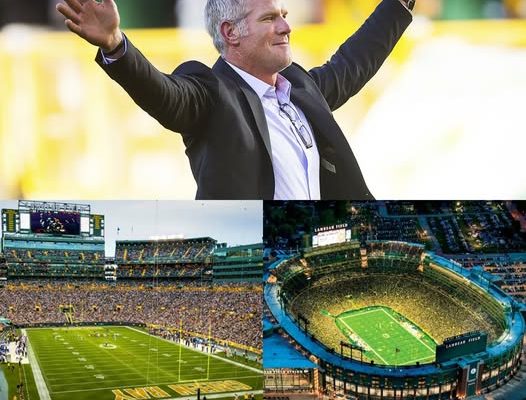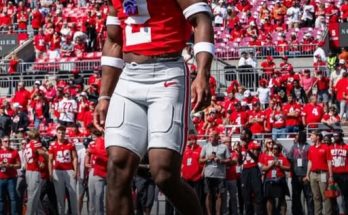The Green Bay Packers organization and its loyal fans were met with extraordinary news this week as legendary quarterback Brett Favre, the man whose name is forever etched in the annals of NFL history, confirmed an incredible act of generosity that left the sports world both astonished and inspired. Favre, known for his record-breaking career and iconic resilience, has donated the full $11.8 million needed for the new stadium project in Green Bay. In doing so, he not only reaffirmed his lifelong bond with the Packers franchise but also sent a powerful message about the enduring spirit of “Packers pride” that transcends time, place, and personal circumstance. With his simple yet heartfelt statement—“Packers pride lives on in me wherever I go”—Favre has once again cemented his place in the hearts of fans, not just as a Hall of Fame quarterback, but as a figure of loyalty and philanthropy who continues to give back to the community that supported him through every pass, touchdown, and challenge.
To truly understand the magnitude of this donation, it’s important to reflect on the deep and complex connection between Brett Favre and the Packers. Favre, who led the team to a Super Bowl XXXI victory and revitalized Green Bay football during the 1990s, is regarded as one of the greatest quarterbacks of all time. His on-field achievements include three consecutive NFL MVP awards, over 71,000 passing yards, and 508 touchdowns—numbers that speak volumes about his impact. Yet, even beyond the statistics, Favre became synonymous with the grit, heart, and blue-collar work ethic that defines Green Bay as a football town. His time with the Packers wasn’t just about winning games; it was about igniting a culture of belief, perseverance, and community spirit. Over the years, despite the occasional controversy surrounding his retirement and eventual stint with rival teams, Favre’s legacy in Wisconsin has remained largely untarnished, and this donation serves as a testament to the enduring love he has for the franchise and its fans.
The $11.8 million donation is not just a financial contribution; it is a symbol of Favre’s recognition of what the Packers have meant to him and what he hopes they will continue to mean to future generations of fans and players. The new stadium project, which has been in the works for some time, is designed to blend modern facilities with the historic charm of Green Bay football culture. While Lambeau Field remains the crown jewel of the NFL and a symbol of tradition, the Packers organization has been working toward building a complementary state-of-the-art facility that would serve multiple purposes: from training and fan engagement to hosting community events and expanding the team’s outreach. The project is not meant to replace Lambeau Field but to enhance the overall experience for players, fans, and the local community. Favre’s donation effectively ensures that this ambitious project can move forward without delay or financial hurdles, something that team officials have described as “a dream come true.”
Packers CEO and President Mark Murphy spoke publicly about Favre’s generosity, calling it “a moment that transcends football.” In his statement, Murphy highlighted how Favre’s contribution is not merely about money, but about legacy, pride, and the deep emotional connection between the team’s past and future. “Brett has always represented what it means to be a Packer. His passion, his leadership, and his authenticity on the field mirrored the values of this community. For him to step up and fund the entirety of this project speaks volumes about his character. This is not just about building a stadium; it’s about building a future, about continuing the story that started long before any of us were here and will continue long after we’re gone,” Murphy said.
The news of Favre’s donation has resonated far beyond Wisconsin. Fans from across the country, and even internationally, have expressed admiration for his selflessness. Social media platforms have been flooded with messages of gratitude and nostalgia, with fans recalling their favorite Favre moments—from his emotional game after his father’s passing to his fearless plays that defied logic yet often ended in brilliance. Many have pointed out that while athletes often talk about giving back, Favre’s $11.8 million gift is a tangible and transformative act of giving that will have a lasting impact for decades. Some sports analysts have even compared this gesture to iconic moments in sports philanthropy, noting that very few professional athletes, especially those retired, contribute on such a grand scale to the very organizations where they made their name.
For Favre, however, the decision seems to come from a deeply personal place. In interviews leading up to the announcement, he spoke about the sense of belonging and gratitude he has always felt toward Green Bay. “When I first arrived in Green Bay, I was just a young kid trying to prove myself. The fans, the organization, and the city embraced me like family. Every cheer, every boo, every cold winter game—they all shaped me, not just as a player but as a man. I’ve always believed that the Packers are more than a football team. We’re a community. We’re a family. And family looks out for each other,” Favre explained. His words echo the ethos of the Packers, a team unique in its ownership structure, with thousands of fan-shareholders who see themselves as part of the team’s fabric.
The logistics of the donation and project are already in motion. The Packers organization has confirmed that the funds will be allocated directly to the construction, development, and operational planning of the new stadium complex. The facility is expected to feature cutting-edge training amenities, fan zones, interactive exhibits honoring team history, and spaces for community gatherings. The architectural vision for the project draws inspiration from Green Bay’s storied past while embracing modern design elements that will keep the franchise competitive in the evolving landscape of professional sports. With Favre’s contribution covering the entirety of the costs, the project timeline has been accelerated, and ground-breaking is expected to begin in the coming months.
Favre’s act of generosity also serves as a broader commentary on the role of athletes after retirement. While many legends fade into the background after their playing days, Favre continues to engage with the game and the community that made him a household name. His post-retirement journey has seen its share of challenges and controversies, but this donation marks a powerful chapter in his story—one that shifts the narrative from past disputes to present-day impact. It underscores the idea that legacies are not just built on what players achieve during their careers, but also on what they give back when the spotlight has dimmed.
In Green Bay, the reaction to Favre’s donation has been nothing short of celebratory. Local businesses have put up signs thanking him, fans have organized rallies to honor his gift, and discussions about how to commemorate this moment are already underway. Some have suggested naming parts of the new facility after Favre, while others believe that his gesture should inspire a new era of community involvement and charity among current players. “Brett has always been larger than life in this town. We celebrated him when he won us games, and now we celebrate him for giving something even greater,” said one lifelong Packers fan who attended a local event celebrating the news.
The broader NFL community has also taken notice. Several former teammates and rivals have publicly praised Favre, calling his donation a reflection of the true meaning of leadership and gratitude. Hall of Fame defensive end Reggie White’s family released a statement noting that White, who shared so many defining moments with Favre on the field, would have been proud to see this level of commitment to the franchise and community. Current NFL players, too, have taken to social media to express admiration, with many calling Favre’s move an inspiration for the next generation of athletes to give back in meaningful ways.
Economically, Favre’s donation is expected to have a ripple effect in Green Bay and beyond. The new stadium project is projected to create hundreds of jobs, from construction to operations, and to generate increased tourism and revenue for local businesses. Green Bay, while deeply tied to its football identity, also thrives on the sense of community that events like these foster. The enhanced facilities will not only benefit the Packers but will also provide a venue for local high school championships, concerts, and community programs. City officials have already spoken about the potential for the new stadium to become a hub of activity year-round, further strengthening the bond between the team and the city.
The story of Brett Favre’s donation also highlights a larger cultural narrative about the role of sports in American life. Football, especially in towns like Green Bay, is not merely a game—it’s a way of life. Generations of families gather to watch the Packers play, and Lambeau Field is treated like a temple of tradition. For Favre to invest in that legacy at such a high level is to acknowledge that the Packers are not just an organization, but a symbol of resilience, unity, and collective identity. His statement, “Packers pride lives on in me wherever I go,” resonates because it speaks to something deeper than wins or championships; it speaks to belonging, to roots, and to the kind of enduring loyalty that is increasingly rare in professional sports.
As the sports world continues to react to this monumental act of giving, one cannot help but reflect on Favre’s journey. From his early days in Kiln, Mississippi, to his rise as one of the most celebrated quarterbacks in NFL history, Favre’s career has been defined by moments of triumph, controversy, and redemption. His fiery competitiveness on the field was matched only by his humility and humor off it, making him one of the most relatable and beloved figures in the league. This donation, though financial in nature, feels like another signature moment in his story—a moment that encapsulates who he is and what he stands for.
There is also a sense of poetic symmetry to this chapter in Favre’s life. He gave the Packers everything he had during his playing days—his talent, his leadership, his heart—and now, years after retiring, he continues to give, albeit in a different way. It’s a reminder that being a legend isn’t just about what you do when everyone is watching, but also about what you do when no one expects anything more from you. Favre didn’t have to make this donation. He had already secured his place in history, already had his jersey retired, already received the cheers of countless fans. And yet, he chose to give, to invest in the future of the team and community that shaped him. That choice speaks volumes about his character.
For many Packers fans, this moment has brought a sense of closure to any lingering questions about Favre’s relationship with the team. While his departure from Green Bay was complicated and his time with the Minnesota Vikings added some tension to his legacy, all of that now feels like a distant memory compared to the magnitude of this gesture. Favre’s donation is a reminder that no matter where life takes you, the bonds forged in moments of shared triumph and challenge remain unbreakable. His words, “Packers pride lives on in me wherever I go,” are not just a sentiment—they are a promise.
As the new stadium project begins to take shape, Favre’s influence will be felt in every brick, every blade of grass, and every cheer that echoes through the stands. Generations of fans will walk through the gates of the new facility knowing that it was built not just with funds, but with love, loyalty, and a deep respect for tradition. The young quarterbacks who train there will do so under the shadow of a man who defined what it meant to be fearless and determined. The fans who gather will do so with the knowledge that one of their own—a player who once wore the green and gold with pride—helped make it all possible.



